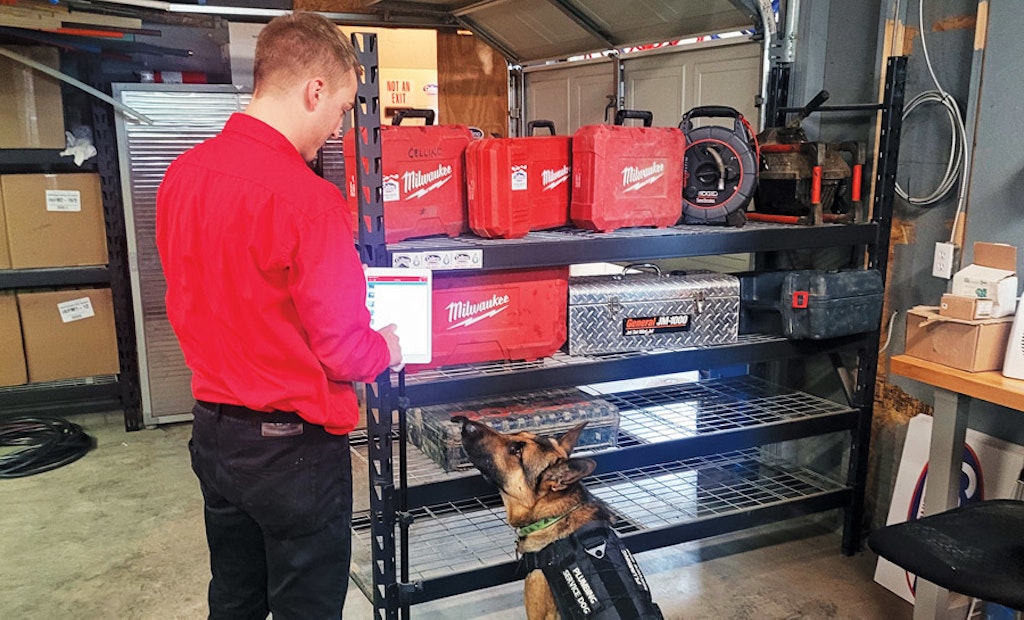
Lucas Cellino, co-owner and president of Cellino Plumbing in Buffalo, New York, checks out a tool using the Milwaukee Tool One-Key asset-tracking system while Rex, the company’s mascot, looks on.
Interested in Business?
Get Business articles, news and videos right in your inbox! Sign up now.
Business + Get AlertsWith 32 technicians, 29 service vehicles and hundreds of tools and machines, there’s great potential for inefficiencies caused by misplaced tools at Cellino Plumbing in suburban Buffalo, New York.
Or at least there used to be. Ever since the company invested in One-Key asset-tracking technology from Milwaukee Tool, that’s no longer the case, says Lucas Cellino, co-owner and president of the company, established by his father, Tony, in 1995.
“I was a little skeptical at first,” Cellino says of the app-based, inventory management software, which technicians access via their cellphones and/or tablets. “I thought it was a neat concept that still wouldn’t do us much good.
“But once we fully committed to putting the Ticks (a small Bluetooth tracking device) on almost every tool, it works great. If you use it just with Milwaukee Tool products that have a built-in Tick, but have other tools without Ticks, it’s hard to build good processes and procedures around them.”
No more cameras MIA
As an example of how One-Key technology improves efficiency and profitability, Cellino points to the company’s pipeline inspection cameras (six RIDGID SeeSnakes, one made by Hathorn and one from Vivax-Metrotech).
“We often wouldn’t know which technicians had which cameras. We’d have to call the warehouse manager and hopefully he’d know who has the cameras. And if he didn’t know, we’d have to send out a mass text message to all our technicians. Now we always know exactly which truck the cameras are on.”
That’s critical, Cellino says, because how fast technicians can perform pipeline inspections directly correlates to higher closing rates on selling pipe rehab jobs. According to company metrics, if a technician inspects a line within 24 hours of a customer’s call for service, the odds of successfully selling the job jump by 33%.
“Because sewer-rehab jobs generate our highest profit margins, it becomes critical to get those cameras on site as quickly as possible — and One-Key helps us do just that,” he says.
Reduce inventory loss
The company has installed about 150 Ticks on a wide range of equipment, including non-Milwaukee Tool devices such as RIDGID drain machines. The business does plumbing service and repairs, pipe bursting (using equipment from Pow-R Mole Trenchless Solutions), pipeline rehab (using PipePatch point-repair technology from Source One Environmental) and HVAC work.
The business also owns an O’Brien water jetter (3,000 psi at up to 14 gpm), a brand owned by Hi-Vac Corp.; and an Isuzu jetting truck equipped with a Hackney box body and a US Jetting 4018 water jetter (4,000 psi at up to 18 gpm).
Even the parts bins in the Hackney shelving systems installed in most of the service trucks are entered into the One-Key database. Tracking the bins helps support a parts-replenishment program, in which all bins are removed from each truck once a month and replaced with fully restocked storage bins. Then the bins that are removed get fully restocked and placed in another truck, Cellino says.
“With this tracking system, we’ve reduced inventory loss (on trucks) by almost half, down to 5% from 9%. We believe just having a strong system of tracking and replenishing holds the techs accountable for properly tracking part use.”
Tracking tools
Because the Ticks effectively are small Bluetooth devices, technicians — and company officials — always know the location of tools and machines. This comes in handy not only on job sites, but if tools are stolen, too, Cellino says.
Any time a phone or tablet that has the One-Key app installed passes within 100 feet of a Tick, it sends data to a cloud-based network, showing the date and time that particular tool was “seen,” as well as its location. A Tick, which typically costs between $25 and $30, is powered by a “coin” battery and can be glued, screwed, riveted or zip-tied to any device.
If a tool is stolen and marked as such on the app, a remote tool lock-out function renders it useless to thieves. And as soon as the One-Key network “sees” the stolen tool, it alerts the owner — even if the battery has been disconnected.
Furthermore, the app provides utilization data that shows how long tools and machines are used. It also provides a digital breadcrumb trail that shows when, where and how tools are used, which helps companies maximize efficiency and productivity. The technology even can provide tool and machine maintenance and service reminders.
Setting up the One-Key system is simple and technicians find it easy to use. The most time-consuming part is entering all the equipment into the Milwaukee Tool database; that took about a day, Cellino says.
“Then all the technicians need to do is download the app and it works like a charm. Downloading the app actually is the hardest part.”
Overall, Cellino says the One-Key technology is a worthwhile investment that has more than paid for itself.
“It has increased our efficiencies and eliminated the stress of looking for missing tools. Time is money and you can waste a lot of time and energy searching for tools. It’s very demoralizing when you’re on a job and can’t find a tool you need to finish a job.”





